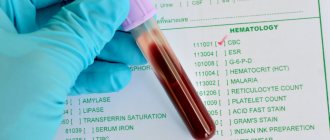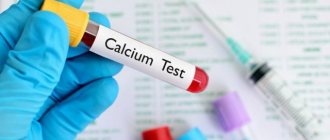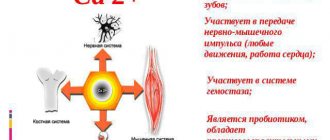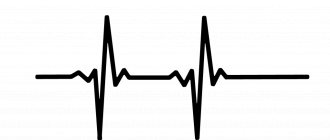1.General information
Probably, any modern person, when asked “Why is calcium needed in the body?” will answer without hesitation: “For the bones.” To a large extent, this is true: almost the entire volume of calcium contained in the body is located in the bone tissues of skeletal structures, and the main processes of its absorption and processing are carried out there. However, it is needed not only “for the bones”.
The role of calcium as a biochemical reagent is much broader and more important: this macroelement (not to be confused with microelements, the required concentration of which is orders of magnitude lower) is involved in the regulation of the processes of excitation-inhibition of the nervous system, desensitization and immune response (it is no coincidence that calcium salts are prescribed for allergic reactions), cellular nutrition, contractile activity of muscle fibers, peristalsis, differentiation of stem cells, secretion of enzymes and hormones, hair and tooth growth.
Nutritional deficiency of calcium, as well as deficiency of other key macro- and microelements (for example, iodine, magnesium, potassium, etc.) at this stage of development of civilization is becoming an increasingly serious problem, since the intake of these substances into the body depends critically on lifestyle and diet, and both are becoming less and less natural for humans. An additional complication is the fact that a deficiency of such elements is most often not the first diagnosis: patients present with symptoms of inflammatory, infectious, metabolic, allergic, gastroenterological and many other disorders - and are treated specifically for them - while the underlying painful condition there lies a deficiency of one or another biologically active substance, which can clearly manifest itself only many years after the first noticeable disturbances appear.
A must read! Help with treatment and hospitalization!
How to understand that the body does not have enough calcium?
Today, 40-60% of the population is calcium deficient, notes the nutritionist. It is often caused by a carbohydrate type of diet (porridge, flour and sweets instead of meat, fish, cottage cheese), an abundance of trans fats (margarine, mainly in industrial confectionery and flour products), taking hormonal contraceptives, as well as chlorination of water.
Photo: istockphoto.com
At the same time, taking a blood calcium test is pointless: if there is a deficiency, it is washed out of the bone tissue to maintain its normal level in the blood. To diagnose hypocalcemia, the level of parathyroid hormone in the blood is checked.
The first symptoms of a lack of this element:
- fatigue;
- general weakness;
- drowsiness even with sufficient sleep;
- fast fatiguability;
- decreased immunity;
- tendency to bleed, for example from the nose or bleeding gums;
- causeless appearance of bruises.
If measures are not taken at this stage, you may then notice brittle hair, deterioration in the quality of nails, tooth enamel will become more fragile, and caries will appear.
Chronic fatigue: how to get rid of a syndrome that prevents you from living fully
2. Reasons
The definition of “nutritional” (food) implies and reflects the main cause of calcium deficiency: insufficient dietary intake. The largest amount of calcium available for absorption is found in dairy products (especially cottage cheese and butter), seafood, eggs, and vegetables. Since calcium is biochemically related to vitamin D, a lack of the latter most often leads to calcium deficiency; Thus, the reasons should also include insufficient exposure to the open sun.
The most significant risk factors include smoking, situations of chronic stress, long-term use of certain medications (cytostatics, antiparoxysmal drugs, etc.).
Visit our Therapy page
INTRODUCTIONPregnancy-associated hypertension (PAH) complicates the course of approximately every tenth pregnancy and is a major risk factor for infant and maternal mortality, as well as severe complications. AGOB includes diseases such as gestational hypertension, preeclampsia and eclampsia. Gestational hypertension is characterized by an excessive increase in blood pressure and usually develops after the 20th week of pregnancy. To be diagnosed with preeclampsia, the patient must have edema, proteinuria, and hypertension. When it comes to eclampsia, life-threatening seizures and coma may occur. AGOB can also lead to premature birth and low birth weight babies. Epidemiological studies in non-pregnant adults suggest that dietary calcium may play a role in the occurrence, prevention and treatment of hypertension. For example, in the Diet for Hypertension (DASH) study, a diet consisting of 8-10 servings of fruits and vegetables and 3 servings of low-fat dairy products reduced systolic and diastolic blood pressure by 5.5 and 3.0 mmHg. respectively, (compared to the typical American diet - few fruits and vegetables, high fat), and a diet rich only in fruits and vegetables reduces these same indicators by 2.7 and 1.9 mmHg, respectively. Although the specific nutrient or nutrients responsible were not identified in the DASH study, it is most likely calcium. A recently published meta-analysis of 33 randomized, controlled clinical trials involving a total of 2,412 patients found that supplementing the diet with 1,000 to 2,000 mg of calcium reduced systolic blood pressure by 1.27 mm (significant difference). Decrease in diastolic pressure by 0.24 mm Hg. turned out to be unreliable. Although the effect of calcium on blood pressure in the general population is very modest, dietary calcium supplementation may be particularly effective in certain subgroups of patients, namely, sodium-dependent hypertension, those with dietary calcium deficiency, and women with hypertension.
CALCIUM METABOLISM DURING PREGNANCY
To provide the calcium needed for fetal bone mineralization, the mother's requirement increases by approximately 300 mg per day during pregnancy. The increase in maternal blood volume, normal for pregnancy, and the increase in calcium excretion in the urine, which are also observed with good nutrition, further increase the woman’s need for calcium. These needs are usually offset by increased absorption of calcium from food, so increasing dietary calcium may not be necessary. The National Academy of Medicine's Nutrition Board recently determined that calcium requirements are 1,000 mg per day for women ages 19 to 50 and 1,300 mg for women under 18 years of age, regardless of pregnancy. The pathogenesis of AGOB has not yet been fully deciphered, however, with this condition, certain changes in calcium metabolism are noted. It is possible that serum concentrations of 1,25-dihydroxy vitamin D decrease, serum ionized calcium concentrations decrease, and calcium excretion in urine decreases. Whether these biochemical changes are a cause or a consequence of AGOB, or both, is unclear. Calcium absorption was not measured in pregnant women with AOHB. However, evidence from epidemiological studies suggests that there is a negative correlation between the amount of dietary calcium and the incidence of AOHB in certain populations. For example, in rural areas of Guatemala, despite poor socioeconomic status and low dietary protein, the incidence of eclampsia is very low (less than 0.4 cases per 1000 births). The amount of calcium in the diet of this population is quite high (approximately 1100 mg/day) because they eat many lime dishes. In contrast, in Colombia and India, where dietary calcium levels range from 250 to 350 mg/day, the incidence of eclampsia is much higher (1.6 and 12.0 per 1000 births, respectively). In a study by Marcoux et al. There was a relationship between the incidence of gestational hypertension and the daily dose of calcium consumed. Interestingly, no such association could be established for preeclampsia. The authors suggested that women with gestational hypertension are a heterogeneous group, some may be classified as mild preeclampsia, while others simply have hypertension first diagnosed during pregnancy. It is the latter group that may be the most It is the latter group that may be most responsive to calcium administration. Another biochemical abnormality observed in pregnant women with arterial hypertension is an increase in the concentration of free calcium inside the cell. For example, compared with controls whose blood pressure was normal, women with preeclampsia had increased free calcium concentrations in their red blood cells and platelets. However, not all studies have detected changes in the renin-angiotensin-aldosterone system. The biochemical mechanisms responsible for increasing intracellular calcium concentrations and decreasing extracellular calcium concentrations are currently unclear. It is assumed that parathyroid hormone plays the main role in cation transport. Unfortunately, studies of parathyroid hormone concentrations during normal pregnancy and during AGOB turned out to be uninformative. This is due to various reasons: the design of these studies, methods for determining parathyroid hormone and the amount of calcium in food. For example, in pregnant women with normal blood pressure, the concentration of parathyroid hormone was higher, lower, or the same as that determined in non-pregnant women. Also, in women with AGOB, the concentration of parathyroid hormone was lower or the same as in healthy pregnant women. At present, the mechanisms of the positive effect of calcium nutritional supplements on blood pressure remain undiscovered. Numerous clinical studies have been conducted in pregnant women to evaluate the effect of calcium supplementation on the incidence of headache and pregnancy outcome. The meta-analysis by Bucher et al was based on data obtained from 2549 women who took part in 14 randomized, controlled trials (which were considered the best among 666 studies performed between 1966 and 1994). Women were given supplemental calcium at a dose of 375 to 2000 mg per day (in most cases the dose was close to the upper limit), and this led to a statistically significant decrease in systolic blood pressure by an average of 5.4 mm Hg, and diastolic blood pressure. pressure by 3.44 mm Hg. Compared with placebo, calcium supplements reduced the incidence of gestational hypertension and preeclampsia (differences were statistically significant). These data are consistent with the results of earlier studies. Although some studies recruited women at risk for AHB, most programs recruited only those with normal blood pressure at baseline. It is possible that the hypotensive effect of calcium supplements may be much greater in the group of patients with AHB. In support of this hypothesis, Knight and Keith, in a randomized, controlled clinical trial that included both normotensive and pregnant women with hypertension, showed that calcium supplementation (1000 mg/day) significantly reduced diastolic blood pressure only in the group of patients with arterial hypertension. Bucher et al. The incidence of hypertension in pregnant women with low dietary calcium due to certain dietary habits has not been assessed. In almost all cases where women were informed about the diet, calcium intake was still below the recommended figure of 1000 to 1300 mg per day. Several studies and meta-analyses have been conducted in the Andes, a rural area of Ecuador where typical calcium intake was less than 300 mg/day. Also included in the meta-analysis were studies conducted in Guatemala, Argentina, and India, where the average calcium intake was less than 600–800 mg/day, 650 mg/day, and 500 mg/day, respectively. Also published were the results of a study that included African American and low socioeconomic status women whose calcium intake averaged 600-650 mg/day). Only in two studies did calcium intake approach the recommended level: 900-1100 mg/day in a group of African-American and Argentinean women; in adolescents, calcium intake did not exceed 1200 mg per day or was less. The Multicenter Eclampsia Prevention Trial was recently published, the data of which contradicts the results of the above meta-analysis. This study included 4,589 women of varying ethnic backgrounds and socioeconomic status whose average calcium intake was less than 1,100 mg per day, and across this large group there was no benefit from dietary supplementation in reducing the incidence of preeclampsia or AOHB. 2000 mg calcium per day. One possible explanation for these inconsistencies may be that dietary calcium supplementation is only effective in those with low dietary calcium. However, in the Eclampsia Prevention Study, no effect of dietary calcium supplementation was observed, even among those women (884 women) who had the lowest dietary calcium dose (average 422 mg/day). Another possible explanation for these discrepancies lies in the age of the subjects. Several studies in the meta-analysis included pregnant adolescents, whose calcium requirements exceed those of adults due to ongoing bone mineralization. This hypothesis is supported by the results of a recently published randomized, controlled trial that was conducted in Ecuador and included 260 pregnant adolescent girls (age less than 17.5 years, mean calcium intake less than 600 mg/day). They were prescribed an additional 2000 mg of calcium per day or a placebo. Calcium supplementation resulted in a significant reduction in blood pressure by 9.1 mm Hg systolic and 6.0 mm Hg systolic. diastolic. However, in the Eclampsia Prevention Study, even in the youngest (ages 12 to 16 years, n=665), dietary calcium supplementation did not have any beneficial effect on blood pressure.
HOW DOES ADDING CALCIUM TO THE MOTHER'S DIETE AFFECT THE OFFEST?
A meta-analysis by Buchner et al. also aimed to study pregnancy outcome. Compared with placebo, dietary calcium supplementation did not significantly reduce preterm birth. Similarly, although there was a trend towards a decrease in the incidence of operative delivery, intrauterine growth restriction, and perinatal mortality in the calcium group, there were no statistically significant differences in these two indicators in the two groups. One possible explanation for the fact that the hypotensive effect does not appear to alter pregnancy outcome is that there have been very few studies (only five in this series) examining the effect of dietary calcium supplementation on pregnancy outcome. However, the Eclampsia Prevention Study also found that dietary calcium supplementation affected the incidence of preterm birth, small-for-gestational-age births, and perinatal mortality. It is most likely that calcium reduces the degree of arterial hypertension and proteinuria without any effect on uterine contractility. It has recently been suggested that maternal diet during pregnancy may have long-term effects on blood pressure in the offspring. To explore this possibility, Belizan et al. conducted a study that included 591 children whose mothers participated in a calcium supplementation study 7 years before their birth. In the group of children whose mothers received calcium, systolic blood pressure was significantly lower than in the group whose mothers received placebo. The risk of high systolic blood pressure in the group whose mothers received calcium was significantly lower than in the placebo group.
CONCLUSIONS
There is evidence to support the beneficial effects of dietary calcium supplementation in the prevention and treatment of pregnancy-related hypertension. However, there are still many controversies in this area. The mechanisms through which calcium can lower blood pressure are not yet known. There is no reliable evidence that adding calcium to food will benefit all pregnant women. However, in high-risk groups, such as pregnant teenagers, and those who are likely to develop pregnancy-related hypertension, calcium supplementation may be beneficial. More research is needed to identify those groups who need calcium supplementation. It is also interesting to determine whether women with AGOB have calcium malabsorption, and when calcium supplementation should be prescribed: in early pregnancy, when changes in calcium homeostasis begin, or in mid-pregnancy, when most clinical studies are conducted, and whether it can replace taking calcium and introducing a large amount of dairy products into the diet.
Dietary calcium and pregnancy-induced hypertension: is there a relation? Lorrene D Ritchie and Janet C King Am J Clin Nutr 2000; 71(suppl):1371S-4S.
3. Symptoms and diagnosis
Classic symptoms of calcium deficiency include asthenia, frequent and painful muscle spasms (cramps), especially in the extremities, bone pain, caries, disorders of the immune and hematopoietic systems (in particular, a tendency to bleed due to insufficient clotting). In more severe and advanced cases, deformation of various structures of the musculoskeletal system, osteoporosis (thinning and fragility of bone tissue) and, as a consequence, frequent fractures are observed; urolithiasis, tooth decay, diseases of the gastrointestinal tract, liver, kidneys; hypothyroidism, tetanic (muscular-spastic) attacks, tremor, multiple sclerosis.
It is obvious that calcium deficiency is very dangerous in childhood, when the skeleton and other key systems of the body are being formed. Often such insufficiency is revealed during examination of patients with rickets; Often, children with calcium deficiency develop abnormalities in the structure of the lens of the eye, serious psychoneurological disorders, convulsive syndromes, flat feet, etc. Reduced blood clotting in childhood makes any scratch dangerous, and in some cases causes fatal bleeding.
Calcium deficiency is preliminarily diagnosed based on the results of examination, history taking and study of the clinical picture. The diagnosis is confirmed by laboratory tests.
About our clinic Chistye Prudy metro station Medintercom page!
4.Treatment
The most effective and natural way to restore the optimally required calcium concentration is a fortified diet. It should, however, be understood that any diets, like all other treatment regimens, activities, procedures, can be developed and prescribed exclusively by a doctor.
The same applies to special calcium-containing supplements and drugs intended for the treatment of the most severe cases of calcium deficiency: such drugs can only be used as prescribed by a doctor.







